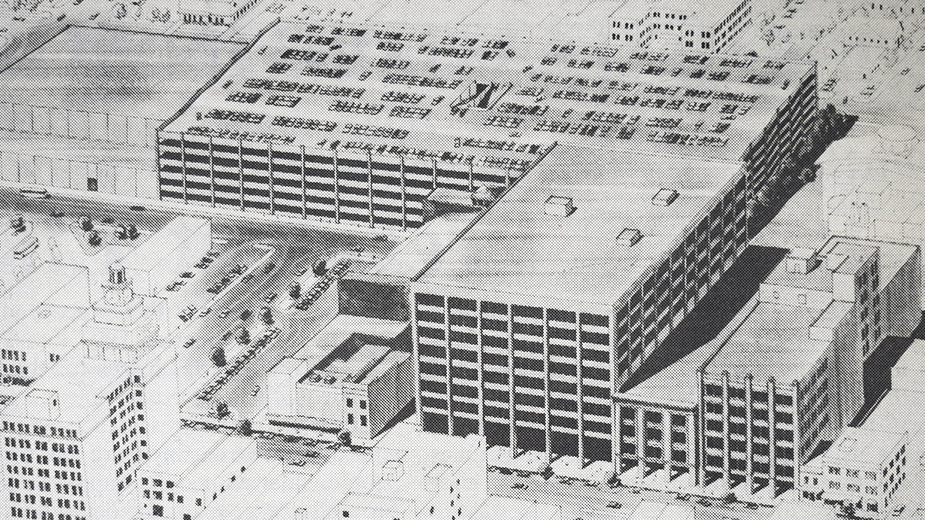YOUNGSTOWN, Ohio – The effort to secure a federal Defense Finance and Accounting Service center was one of the first large-scale efforts by Mahoning Valley leaders to achieve a regional goal.
The objective was to land one of up to seven payroll processing centers, each of which was expected to create 4,000 to 7,000 jobs, according to a story in the MidApril 1992 Business Journal.
Then-U.S. Rep. James A. Traficant Jr. asked the Western Reserve Port Authority, the new two-county entity formed to assume operation of what was then Youngstown Municipal Airport, to serve as the bidding agent for the $100 million project.
At a news conference, Traficant and businessman J.J. Cafaro announced that the Edward J. DeBartolo Corp. had offered to donate a 100-acre parcel in Liberty Township for the site. Plans called for submitting proposals for two locations: a suburban site in Trumbull County and a downtown Youngstown site, the former Higbee department store building and adjacent properties.
Traficant also suggested a tax structure to finance the project that would include, but not be limited to, property taxes in the two-county region.
“This project is too big for any one community. We’ve got to develop it on a regional basis, finance it on a regional basis and operate it on a regional basis, regardless of where it’s located,” Traficant said.
Our editorial in the following edition, May 1992, reflected on the value of the joint effort itself. It praised Traficant for marshalling his political influence to “unite disparate elements of the community” and also area business leaders for their contributions, such as providing funds for preliminary site work.
“Final selections are a year off, but the Mahoning Valley can look to this effort as a victory already, from the mere fact that so many have come together to make this project a reality,” the editorial offered. “Even if the Mahoning Valley is passed over for one of the centers, this campaign can serve as a model for future initiatives.”
The port authority met the June 1, 1992, deadline and submitted three proposals: a 4,000-employee facility in downtown Youngstown that would incorporate the former Higbee building; a 7,000-employee center on the Liberty Township site donated by DeBartolo; and a 4,000-employee building on the same Liberty site.
Construction would be financed by a half-percent sales tax that would go before voters. One estimate put construction costs at $110 million for the larger center, which would have a $245 million annual payroll. Traficant, who predicted the Pentagon would make its selection during the first quarter of 1993, expected each 100 jobs at the center to generate 80 additional jobs.
On Dec. 2, 1992, Traficant confirmed that Youngstown’s proposal was among 20 finalists for one of the centers. Competitors included submissions from Saginaw, Mich., Evansville, Ind., and Cleveland. Communities were to present a “best and final offer” to the U.S. Department of Defense by Jan. 4.
“All three of our sites are acceptable, but we have been asked to submit one 4,000- and one 7,000-employee facility for the final analysis,” the congressman said. “I’ve been notified by the congressional sources that our proposal is, at this point, one of the top proposals in the country.”
Local leaders subsequently decided to submit a proposal calling for either a 4,000- or a 7,000-employee facility to be built on the Liberty site. Once the Jan. 4 deadline was met, submitting communities would have until Feb. 15 to make modifications to their proposals, and the final decisions were to be announced March 15, 1993, we reported.
Our MidJanuary 1993 editorial touched on how collective planning such as the payroll center proposal appeared to be gaining strength and hinted that a merger of the chambers of commerce in Youngstown, Warren and Niles was all but “a done deal.”
Reid Dulberger, then executive director of the Youngstown Area Chamber of Commerce’s Regional Growth Alliance, suggested that the realization had “sunk in very deeply that we cannot afford to do things on a separate or parallel basis – we need to benefit from the efficiencies of working together. That’s much more important than the historic issues that have divided us,” he said.
Our MidJanuary 1993 “Confidential” column, which we then published opposite the editorial page, focused on the potential political implications of the Valley securing a payroll center, including how it might affect Traficant’s relationship with the incoming president, Bill Clinton, how he could use it a springboard for a U.S. Senate seat in 1994 and, if elected, help Clinton win reelection in 1996.
The February 1993 editorial focused on a possible referendum for the project sales tax and touched on the Operation: Valley Proud campaign launched by National Uniform Service, as well as efforts by other proponents. A story in the February 1993 edition reported Operation: Valley Proud had secured up to 10,000 signatures in support of the effort.
The editorial in the following issue, MidFebruary 1993, bore the headline, “One Step Forward, Two Back Makes for Slow Going on Pentagon Project.” It detailed various ups and downs of the project to date, including the latest bump in the road, when the Port Authority discussed behind closed doors hiring a firm owned by Cafaro – who had headed the site selection committee – for the project. Although port authority board members swiftly acknowledged and corrected their error, another flap erupted over the amount of project consulting fees.
Then the hammer fell.
The MidMarch 1993 edition carried the headline that project proponents were dreading, and which cynics likely saw as inevitable: “Pentagon Project Nixed; Valley Moves Ahead.”
On March 12, 1993, U.S. Defense Secretary Les Aspin rejected the process that had been initiated to consolidate the Defense Finance and Accounting Service – or DFAS – centers and promised to review options.
A Washington, D.C., analyst contended that Aspin didn’t like the way the payroll and accounting megacenters were being “auctioned off,” pitting communities against each other that were “mortgaging their futures by passing bond issues.”
Dulberger, now vice president of economic development for the new Youngstown/Warren Regional Chamber, aimed to build on the momentum of the effort.
“Whether or not we ever get a finance center, we had one of the best proposals and I think it shows we can do a lot if we put our minds to it. Let’s also identify the dozen projects we need over the next 10 years and put that same energy behind it,” he said.
Our subsequent editorial likewise acknowledged the value of the effort, even as it lamented the project’s demise.
That the local proposal was among the 20 finalists and rumored to be among the top five “underscores what can happen when communities ignore meaningless political boundaries and collectively focus on reaching a carefully targeted goal,” we said. “Clearly, we held our own with the best – and we can do so again.”
Pictured at top: The rendering submitted for the downtown Youngstown site.

